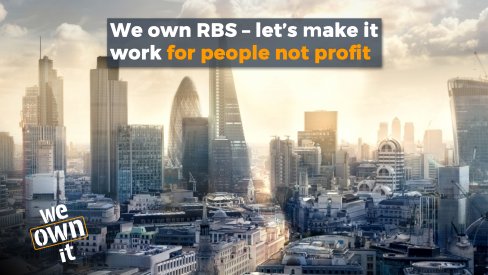
13 November 2017
Here's a great article from the Common Weal website giving people advise on how to respond to the consultation on a Scottish National Investment Bank:
The public consultation on the implementation plan of the Scottish National Investment Bank closes on 20 November. You can access the consultation here.
Common Weal will be submitting a full response to the consultation, but we want as many individuals and groups as possible to submit their own responses – it is better if responses are not just copy & pasted from here, but is based on the key principles of a Common Weal approach.
To help with this, we have written the following guidance document to assist you in thinking about what you would like to put in your response.
We would encourage you to think about including the experience of your local area or personal experience.
It is not necessary to answer every question; you can pick the questions that you are most confident in answering.
We are not therefore going to recommend exactly which answers you may wish to give but to provide a framework for establishing your own priorities.
What is the purpose of the bank and what can it do?
Common Weal believes the bank should be seen as a means of providing finance in circumstances and in ways where the market has not worked effectively – whether that is because finance has been unavailable or available on the wrong terms.
The bank should not be seen as only being to 'plug gaps'. It should be seen in its totality as a tool to help influence the structure and working of the economy for public good purposes.
It must be a proper bank – it must have the power to create credit and it must not be either a grant giving body or reliant on annual grants from government. It must be self-sustaining and self-sufficient.
The ‘public good’ mission of the bank (the things it should be trying to achieve) should be written into its constitution.
The kind of core purpose we believe the bank should pursue might include:
• Promote the long term sustainability and survivability of enterprise in the Scottish economy, emphasising long-term borrowing which offers security and partnership working to maximise the longevity of relationships.
• Encourage diversity of ownership model (private company, social enterprise, mutual, cooperative, community ownership), promote domestic ownership of enterprise (more enterprises owned in Scotland) and 'anchor' enterprises to prevent them being bought up and jobs exported.
• Rebalance the economy, between types of enterprise (for example, between retail and manufacturing), between sectors of the economy and between other activities and practices which have a core public economic impact (for example, between private home ownership and public and private rental options).
• Promote public good outcomes from economic activity such as reducing poverty, improving equality, reducing gender pay inequality, improving environmental performance and so on.
• Improve quality and level of development of industry including rates of innovation, stage of technological development and level and nature of productivity.
• Influence balance of trade and balance the rate of imports and exports.
• Affect differential rates of regional development, supporting and prioritising growth in low-growth regions.
• Achieve reasonable returns on investment, but never be profit-maximising, particularly at the expense of the missions outlined.
• Improve national public infrastructure through partnership working with the public sector.
You should think about what kind of key economic interventions are needed in your area or in subject areas you have a specific interest in and prioritise those in your response.
Who should it lend to?
We believe that SNIB should have no restrictions on who it lends to. It should be as likely to invest in public infrastructure projects as small business start-ups and major expansion in existing enterprises (to support new developments or export pushes etc.).
It is vital that public investment is not ignored: the bank could play a major role in replacing the public-private partnership model in public infrastructure, and could help overcome the chronic lack of public investment from the UK Government, including investing in public rental housing and a national energy company.
It would be really helpful if you are able to think of any specific examples of kinds of intervention in your area that can illustrate this – perhaps thinking of local or regional businesses (or sectors) that might use support or big infrastructure projects that could be supported or initiatives that you think the bank could support that are particularly important to you. It is always helpful if you can explain the benefit this would bring (“we are desperately short of housing and if the bank was to support the local authority in long-term lending to enable major supply of public rental housing then the impact in this area would be...”, “we've lost a major employer in this area and to diversify the economy it would be great if there was major investment in the following kinds of local enterprises...”).
Should the bank have a regional/local mandate?
Common Weal supports the idea of SNIB supporting a network of smaller banks dealing specifically with economic activity in their area, especially small businesses. This is the best model for a lot of specific regional support and development – for smaller and newer businesses having ongoing direct contact with a lender who knows local conditions and specialises in supporting that kind of businesses would be best. But the SNIB itself should have a specific mission element to look at regional development and to support and ensure equality across Scotland. This should be supported by the overall spread of investments from the bank.
How should the bank be governed?
In some ways this may prove to be the single most important aspect of the set-up of the bank.
Governance simply means who and how decisions are made in the bank, particularly at the oversight level. It means who sits on the Board or the policy committees and how they are appointed. Again and again it has been shown that if the governance of an institution is dominated by one group of people, the institution as a whole starts to behave like that group and sees its purpose and priorities through their eyes. So while it is essential that the bank is grounded in solid financial sector experience and is run by people who know how to run a bank, it is also important that the bank does not therefore take on the nature of the kind of banking sector it is being created in part to rebalance.
We believe that there are three main interests that should be represented in the bank's governance. One is financial responsibility – it must be properly run, be financially stable and sustainable, work to a proper and effective business plan and so on. One is the 'public good' role, representing democratic interests as well as core social stakeholder issues (for example, in the interest of workers, equalities and the environment). One is the economic development interest, at a national level but very particularly focussing on the enterprises and other entities borrowing from the bank.
We recommend a tripartite 'stakeholder' model where governance is balanced equally between these interests. This might mean one third of the board being made up of financial sector expertise, one third of representatives of government, parliament, local authorities and civic organisations such as trade unions, and also perhaps individuals with environmental expertise. The final third might include representatives of the kinds of entities that will borrow – from local authorities to small businesses.
Should the bank be public or private sector?
We believe that public-sector ownership of the bank is the only way to ensure that it sticks to its public good mission over the long-term. This model has the added benefit of reducing borrowing costs for the bank and ensuring all profits are re-invested. There is not one model of public ownership – the bank could be part-owned by the Scottish Government and part-owned by local authorities, and it could have social stakeholders invested in it such as credit unions and housing associations. This could help provide a balance of stakeholders and prevent any future attempt at privatisation, like the selling off of the UK Government Green Investment Bank earlier this year.
Want to know more?
We would also recommend the following resources for further reading:
Building Scotland’s Future Now – A new approach to financing public investment

Image taken by Dunnock_D in Kinburn Park, St Andrews, Scotland. https://www.flickr.com/photos/dunnock_d/26387222424/in/photolist-GcKpUL-84MoW5-kqz9xV-VRS3qq-9F6WAv-TQQE9Y-WEkGDn-mhgenR-a72JUF-VW5PVp-ZgnWcE-9n6FKT-ekRARh-goGdK2-dpveNW-dsdDS9-wY1rs5-q6Qnyz-anxoqR-UTUuAH-9ZXzz9-qKtB6p-h31ABv-oZUHtE-rk4DjF-fEoXE5-s3vQdH-jhntym-86Uor8-ph8wm8-dt1gPy-6bQ1Fw-2XQ7tp-ajcQcM-8Aok5S-5LrT7Z-8uvoCZ-56SH48-4ieac9-4oZuFH-aFUfHn-hXMtBQ-oUcm8L-4oYtJT-Jscfw-JsbPb-aiLnQp-oZAhqN-6xwuc4-nVKEVQ



Add new comment